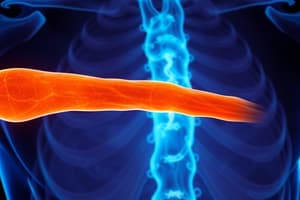Podcast
Questions and Answers
What is the presentation of myositis?
What is the presentation of myositis?
Dermatomyositis, Polymyositis, Inclusion body myositis, Statin induced myopathy, Rhabdomyolysis
What are common features of dermatomyositis compared to polymyositis?
What are common features of dermatomyositis compared to polymyositis?
- Facial and ocular involvement
- Higher risk of malignancy (correct)
- Involvement of skin rashes (correct)
- Proximal muscle weakness
Dermatomyositis is typically associated with a lower risk of malignancy than polymyositis.
Dermatomyositis is typically associated with a lower risk of malignancy than polymyositis.
False (B)
What age group is most commonly diagnosed with DM/PM?
What age group is most commonly diagnosed with DM/PM?
What are some clinical features of DM/PM?
What are some clinical features of DM/PM?
In myositis, the typical serum creatinine kinase levels are usually in the ______.
In myositis, the typical serum creatinine kinase levels are usually in the ______.
What is the traditional gold standard for investigating myositis?
What is the traditional gold standard for investigating myositis?
Which abnormalities can be found in skin biopsy for dermatomyositis?
Which abnormalities can be found in skin biopsy for dermatomyositis?
Facial involvement is common in both dermatomyositis and polymyositis.
Facial involvement is common in both dermatomyositis and polymyositis.
What type of muscle involvement is primarily affected in DM/PM?
What type of muscle involvement is primarily affected in DM/PM?
Match the following signs/rashes with their corresponding conditions in dermatomyositis:
Match the following signs/rashes with their corresponding conditions in dermatomyositis:
Study Notes
Inflammatory Muscle Disease Overview
- Myositis encompasses several types: Dermatomyositis (DM), Polymyositis (PM), Inclusion Body Myositis, Statin-Induced Myopathy, and Rhabdomyolysis.
- DM and PM are considered "rheumatic" and often associated with autoimmune and connective tissue diseases (CTD).
Epidemiology of DM/PM
- Incidence is rare, with 2-10 cases per million people.
- Most adult cases occur between ages 45-65, with a female predominance (sex ratio 2-3:1).
- DM often overlaps with other rheumatic disorders, such as lupus.
Clinical Features of DM/PM
- Characterized by progressive proximal muscle weakness, with symptoms developing over weeks to months.
- Common areas affected include shoulder girdle, neck flexors, and hip flexors.
- Can involve pharyngeal, esophageal, diaphragmatic, and cardiac muscles, although rare.
- Minimal or absent pain, often accompanied by fatigue, weight loss, low-grade fever, Raynaud's phenomenon, and occasional lung disease (Interstitial Lung Disease - ILD).
- Facial and ocular muscle involvement is rare but indicates potential for other diseases.
Unique Features of Dermatomyositis
- DM presents with extra-muscular features that are absent in PM, such as skin rashes and an increased risk of malignancy.
- Key cutaneous manifestations include:
- Heliotrope rash (eyelids and malar areas).
- Gottron’s papules (over knuckles).
- V-sign (chest and neck) and Holster sign (proximal thigh).
- Regular cancer screenings are essential for adults with DM.
Diagnostic Investigations for DM/PM
- Elevated serum creatinine kinase (CK) levels, often in the thousands, are typical indicators of myositis.
- Additional muscle markers that may be elevated include aldolase, AST/ALT, LDH, and myoglobin.
- Abnormal electromyography (EMG) can indicate myopathic changes but is not highly specific.
- Muscle biopsy remains the traditional gold standard for diagnosis.
- Muscle MRI is very sensitive and can identify inflammation in muscle tissue.
- Skin biopsy in DM can reveal interface dermatitis, similar to cutaneous lupus, underlining the importance of lesion location in diagnosis.
Studying That Suits You
Use AI to generate personalized quizzes and flashcards to suit your learning preferences.
Related Documents
Description
This quiz focuses on the identification and presentation of various inflammatory muscle diseases, particularly myositis, including dermatomyositis and polymyositis. It will cover key differential diagnoses such as statin-induced myopathy and rhabdomyolysis. Test your knowledge and understanding of these conditions.




